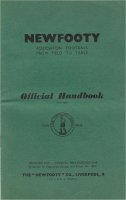
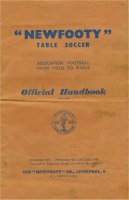
| Peter Upton's |
|
Newfooty Tribute Website. |
|
or 90 Years of Table Football. |
The Newfooty Rules - Official Handbooks 1950s-60s |
Subbuteo was launched in March 1947 and this coincided with Newfooty updating their bases to include a plastic top (I think this arrived in 1948). This advance supposedly made it impossible for the players to fall over in play (they are certainly hard to knock over, although they do tend to fall apart in my experience). From here on, the two games are strong rivals, and I suspect both are watching the opposition fairly closely. It is harder to say from this point what is a Newfooty innovation, and what might be a Subbuteo one. For instance, Newfooty in the early rules allowed one positioning flick at free-kicks and corners, but by this stage it has changed to one flick for a free-kick, and three for corners, which matched Subbuteo.


I think the arrival of Subbuteo also pressured Will Keeling into making his game look much more professionally produced. The two-piece 1948 bases saw a new "Official Handbook" produced, which adapted the game for these new bases, and further clarified the rules. The handbooks included photographs of flicking styles for the first time. Here you can see the very different flicking styles that Newfooty allowed, using the back of the finger and different hand positions. An improved one-piece base arrived in 1953, and the Official Handbook was then revised behind an attractive green and black cover. This version ran into the late 1950s, and maybe beyond. A smaller simple rule sheet with a blue cover featuring Stanley Matthews, was also introduced during this period. This budget version was a single sheet folded to make four pages. By the 1960s and final Crestlin era it seems to be the only rules to be found in the sets, although the Handbook was still in the accessory lists.
I've picked two handbooks to quote from on this page (both owned by me), which give a feel of the 1950s rules. The 1951-52 revision is laid out in full, whereas the later green and black rules have the interesting "tactical talk" articles reproduced, but the rules are mostly summarised, so as not to repeat information.
Official Handbook (1951-52 revision).
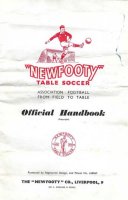
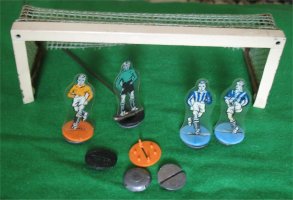
This Newfooty handbook was written to work with the new plastic tops that were added to Newfooty bases in 1948, and lasted until the one-piece base of 1953.
Introduction.
"Newfooty" as invented by us in 1929 and it immediately became popular with all Association Football enthusiasts who became acquainted with it. It is acknowledged as the finest table football invention, being full of real football thrills, and is so realistic in play that almost all football incidents can be reproduced. The rules of the game, used in conjunction with those of Association Football make it the nearest approach to Soccer attainable in a table game.
With "Newfooty" the ball can at times be played while it is rolling, with spectacular effect. It may be passed from the wing across the goalmouth, a man in a convenient position may be played at the moving ball and score, just as a forward may dash in to score in real football. This calls for split-second thinking and action.
Don't expect to become an expert player quickly, it will take time as "Newfooty" is a game of skill. You may even experience some difficulty at first in flicking the men correctly, but you will soon acquire the necessary skill with practice if you follow the instructions carefully. Remember the men are flicked with the finger not pushed - always hold your hand still.
The rules are divided into two sections, the first is for beginners, and the second for experienced players. We would emphasise that they are based on the original rules complied by us in 1929, which we have altered to improve the game during the years that have elapsed since "Newfooty" was first introduced.
Read the instructions for "Assembling Men" carefully before attempting to fit the men together.
In response to many requests we are including in this booklet some of the hints we have given at various times to help players improve their play. We hope they will prove useful to all enthusiastic "Newfooty" players.
This concludes the Introduction and we now pass on to the Instructions and Rules of "Newfooty".
SPECIAL INSTRUCTIONS FOR FLICKING MEN (see illustrations).
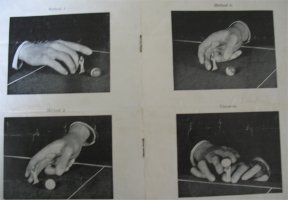
METHOD 1 - Place the back of whichever finger you prefer to use behind the man to be flicked (as in illustration 1). Press the finger down and at the same time move it sharply forward from the middle joint only. Hold your hand still and do not use your thumb at all to grip the finger being used to flick the man. Distance man travels and force with which ball is hit depends upon force applied when flicking the man.
METHOD 2 - Hold your finger pointing downward (as in illustration 2). Move the whole finger sharply from the knuckle, holding the hand as still as possible.
METHOD 3 - Hold the finger as in Method 2, but slightly bent (as in illustration 3), and move it sharply from the middle joint only.
"Newfooty" men are not intended to be flicked long distances, the men near the ball have the advantage as in actual soccer. For an explanation of use for the various methods described see page 10 (okay, it's further down this page!).
GENERAL DATA.
Place the various parts in correct positions on a level table covered with a cloth - green baize for preference, and if possible mark it out to represent a football field with tailor's chalk (see diagram at back of book). Time the game is to last should be arranged and ends changed at half-time.
SIZE OF PLAYING AREA - If possible use a table 5ft x 3ft. with goal lines and touch lines two inches from the edge. Goal area 3ins, each side of posts and 3ins forward. Penalty area 8ins. each side of posts and 8ins. forward. Penalty kick spot 6ins from goal line. Centre line half-way between goals. Centre circle and Penalty area are 6 inch radius.
GOALKEEPER slides into slot on wire holder and is moved by the wire from underneath back of goal to try and save a shot.
CHARGING occurs when a man is flicked against an opponent and the opponent is moved out of position.
GOAL SCORING AREA is the part of the field in both halves nearer to goal line than centre line. A mark can be made on both touch lines to denote the goal scoring area.
*The playing area is pretty much identical to the one used by Subbuteo. But in fairness to both companies, our family dining room table dates from a similar period, and is 3ft by 3ft with extendable flaps that bring it to the required size. I am assuming this is a fairly standard size table.
RULES OF PLAY.
KICK-OFF AND ORDER OF PLAY. Side kicking off plays centre-forward against the ball with the finger, by one of the methods described in the special instructions, so that the ball is played into the opponent's half of the field. If the ball remains in play and has not touched an opponent, the side in play flicks another man at the ball. If they miss the ball then opponent takes next turn.
The object of the game is for each side to try and play the ball into their opponent's goal by flicking their men, one at a time, at the ball, according to the following rules. Each time they touch the ball and retain possession they take another turn.
Side in play loses possession if:-
A:- They miss the ball.
B:- They play it on to an opponent and ball remains in play.
C:- Their man is the last one to touch the ball or be touched by it before it
passes out of play.
D:- They commit any offence which awards a Free Kick to opponent.
E:- Opponent's goalkeeper saves a shot and ball remains in play without being
played back on to a man of side which shot at goal.
F:- They score a goal.
NOTE. - Any man flicked before goalkeeper touches ball, while operated from underneath back of goal, may regain possession or score a goal if goalkeeper plays the ball on to the man. The ball may be played while it is rolling, by side in play, whenever it is convenient.
A goal cannot be scored after a kick-off until at least three men have played the ball. No man may play the ball more than four times in succession. If a man goes off the table after playing the ball a different man of the same side must be flicked next turn.
GOAL SCORING. Before a goal can be scored, the ball must be in the goal scoring area, and the man attempting to score must be in opponent's half of the field.
NOTE. - A goal is allowed if the ball is kicked from outside the goal-scoring area and the goalkeeper is moved in an attempt to play the ball, touches it and it goes into the goal. It is also a goal if a defender tries to intercept the moving ball - see Advanced Rules - touches it inside the goal-scoring area and it enters the goal.
GOALKEEPER, while on the holder operated from correct position, can play the ball any time it comes within reach, irrespective of which side is in play.
FREE KICKS, including Goal Kicks, Penalty and Corner Kicks. Place the ball in the correct position corresponding to that in actual football or where the infringement occurred and the man an inch from it - opponents standing at least 3 inches away - then flick the man against the ball. For a Goal Kick a full back may be used.
THROW-IN (Revised). - Place the man outside of the field. over touch line, where ball passed out. Hold the man and the ball as in illustration No. 4. Press the ball against the head of the man, forcing it slightly backwards, allowing the ball to be forced from between the fingers so that it shoots forward onto the field of play. (Previous Throw-in where ball was "kicked in" from touch line is now cancelled).
NOTE.- Before taking a Throw-in, Corner Kick, or Free Kick, the side in play may flick men into positions of advantage, opponents do likewise. Up to three men may be flicked in this manner if the side in play wishes it. Each man must only be flicked once.
FOUL THROW-IN (revised).- A foul throw-in occurs if the ball travels more than a distance equal to half the width of the field, or if the man is not held in the correct position. The throw-in is re-taken by opponent.
FOUL occurs if the man or ball is not played as instructed.
FOUL CHARGE occurs if any of opponent's men other than the one nearest the ball is charged during play, or if the man is charged roughly, moving it more than about 1/2-inch from original position. If a man being flicked is touching an opponent's man, the opponent must not be moved out of position at all even if nearest man to the ball.
DANGEROUS PLAY occurs if when playing own man touching another of own side both are moved. A goal cannot be scored direct from the free kick.
OFFSIDE is as in Association Football. A man in an offside position is not considered offside until played towards the ball, or the ball is played on to the man by own side. Place all men in offside positions, onside, outside goal scoring area, before taking free kick. A man in an offside position may be placed onside, outside the goal scoring area, before any turn is commenced, but cannot be used in that turn.
PLAYERS OUT OF POSITION may be adjusted by hand whenever the ball is out of play for a goal kick. Men in opponent's half must not be moved towards opponent's goal or any man placed within one inch of opponent. Length of time allowed depends upon the side taking the goal kick. Men crossing touch line or own goal line resume from the point where they crossed the line. If they cross opponent's goal line they resume from an onside position outside the goal scoring area and cannot be used again until opponent has taken a turn.
IF A MAN FALLS OVER after playing the ball, the side whose man is nearest to the ball, excluding the fallen one, takes next turn. If a man is charged over by an opponent it is a foul charge. If men are correctly adjusted they should not fall over - see Assembly Instructions.
If a referee is appointed, his decision is final. When in doubt about a decision, toss up, and the winner continues to play, but if the ball is touching men of both sides at the same time, separate them at least one inch from the ball before proceeding with play.
ADDITIONAL RULES FOR EXPERIENCED PLAYERS.
THE SIDE IN PLAY LOSES POSSESSION if they play the ball into opponent's penalty area and it is allowed to stop, whilst there is at least one of the opponent's men other than the goalkeeper in the penalty area, This rule does not apply if the ball is played into the penalty area direct from a Corner Kick, or a Throw-in taken in the Scoring Area, until the ball has been cleared from the penalty area after the incident.
INTERCEPTION. - When a long pass is made the opponent of side in play can attempt to obtain possession if there is time for him to play a man at the ball while it is rolling, without undue haste. He must not put his hand near the table to make the attempted interception until the ball has actually been kicked.
OBSTRUCTION (New F.A. Rule 1948) occurs if the side in play flicks a man which misses the ball and stops in a position which prevents an opponent's man near the ball from being played directly at it. A goal cannot be scored from the Free Kick.
Both Newfooty and Subbuteo keep an eye on new Association Football rules in an attempt to represent everything they can.
GOALKEEPER can be taken off the holder and flicked at the ball from any point the wire will reach, if the ball has stopped in the penalty area and the goalkeeper's side is to play, but should the man miss the ball or play it on to an opponent, then the opposition take the next turn while the goalkeeper remains out of goal. The goalkeeper may play the ball three times in succession inside the penalty area and once outside of it in any turn, but is not allowed to run out direct to clear a ball that has stopped outside the area unless it was last played by own side.
If an infringement of this rule occurs a free kick is taken from the spot where the incident took place, but a goal cannot be scored direct if it happened in the penalty area as it is a foul for carrying the ball.
HOW TO IMPROVE YOUR PLAY.
To be successful at "Newfooty" it is essential to keep your men well distributed about the field; keep your forwards in your opponent's half and your half backs moving backwards and forwards in each half to help attack or defence. Always try and have your centre half in a good position to stop any up the middle attacks or so it can be played out to either wing in case the wing half backs are assisting the forwards.
Keep at least one full back in the penalty area so you can take advantage of the rule which gives you possession of the ball on certain occasions. Don't try to play the offside game, as it is easily counteracted. Your opponent only has to move the offending man, before commencing any turn, to upset your plans.
With regard to flicking the men the three methods are for different purposes. Method No.1 should always be used to make a shot a goal or a long pass where accuracy is essential. Method No.2 can be used to make a quick shot at a moving ball if the man is in a position where No.1 method cannot be conveniently used in the split second at your disposal. It can also be used to make a short pass or to avoid walking around the table to take a turn providing a high degree of accuracy is not needed. No.3 is for tricky play, especially when you want to touch the ball very lightly. Give the man a sharp, light tap on the side of the base with the finger; this, you will find, makes the man rotate rather than glide. Practice the three methods and note how the men respond.
The direction the ball takes when hit, depends upon where the man hits the ball. If it is hit right in the centre it will go directly forward. If hit on one side it shoots off at an angle, whilst if the base of the man gets under the ball it tends to lift it. To make the man travel in an arc, or swerve, flick the man more at the side than at the back. This needs practice but is well worth trying. We cannot guarantee that you can make the ball rise just when you want it to (yeah, tell me about it), as it all depends upon how the man is travelling when the ball is struck. You will find, however, that by using Method No.1 with the man facing the ball rather than standing sideways towards it, that the ball will often tend to rise.
The celluloid ball is lifted much more easily than the plastic one which is heavier and has a tendency to keep low, but many players prefer this. Practice flicking the men, hitting the ball in different places and study the direction taken by the ball. If you have any difficulty in flicking the men practice with a coin on a smooth surface, this will give you the correct movement of the finger. (and is, in essence the origins of both Newfooty and Subbuteo).
Don't rely on kicking the ball anywhere, always have a plan and try to play the ball or man according to that plan. A higher degree of accuracy is obtained by playing a man near the ball. No distance can be given as this depends upon the skill of the player, but there should be no difficulty in making an accurate shot or pass from a distance of six inches. More accuracy is also usually obtained with short passes rather than long ones, and remember that you can lose possession with a long pass if your opponent has enough time to intercept.
Before a goal kick re-arrange your men to best advantage as the rules permit and never have two men in a direct line, the more unevenly placed they are the more difficult it will be for your opponent. Before a Throw-in or Corner Kick flick the men into position as allowed but if the first man flicked goes to a suitable position do not flick more men unless it is necessary. If your opponent is taking the kick or throw-in see that your man is played into a good position, to cover his most dangerously placed man.
Finally, whenever play is in your half of the field take up a position behind the goal on all possible occasions to be ready for any unexpected shot if the ball reaches the Scoring Area. Keep the goal in position by placing the tips of the fingers of one hand on the top of the goal, and hold your goalkeeper wire with the other hand. Remember it is up to you to be ready to stop a shot as your opponent will try to catch you unprepared.
Having read this booklet you will realise that "Newfooty" offers you all the thrills and excitement of real Soccer, but not until you become an expert player will you fully appreciate all the finer points of the game, and understand why men, who first played the game as boys many years ago, are still keen "Newfooty" enthusiasts.
POINTS TO REMEMBER FROM ASSOCIATION RULES.
These hints are on the inside cover of the 1951-52 rule book, and on the back cover of the later green and black versions.
Whenever a player takes a free-kick or a throw-in he must not touch the ball again intil another man has played it. This includes the place-kick at the kick-off.
If when taking a free-kick ball fails to roll completely over, kick must be retaken. This also applies if ball is not kicked out of penalty area when a goal kick is taken.
OFFSIDE. If "A" plays the ball and "B" (one of his own side) is at such times nearer to opponents' goal-line then "B" is offside unless there are at least two opponents nearer to their own goal-line than "B" is. According to football laws, however, it is not an offence to be in an offside position providing he does not interfere with play or opponents, or attempts to do so. This is the point the referee has to decide. A man cannot be offside from a goal-kick, corner-kick, throw-in, or if ball was last touched by an opponent, or when the man is in his own half at time ball is played.
Unintentional handling of the ball should not be confused with intentional handling.
Official Handbook (1958-59 revision).
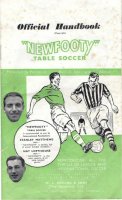
This is a version of the Green Handbook, which ran throughout the late 1950s. The version I've used is dated to 1958-59, but this booklet appears in sets as early as 1954, and so probably covers the arrival of the solid one-piece bases. Unlike Subbuteo, where the text in the rule books actually changes very little, Will Keeling used the arrival of a new rulebook to rewrite pretty much the whole book. However, a lot of the measurements, rules and infringements are pretty similar to the previous book, so I'll gloss over them a little. As with the final section in the 1952 rules, Will Keeling does talk tactics in this book, which was starting to fill out rather like the Subbuteo advanced rules booklet. Unlike the 1952 rulebook, the tactical talk is at the start of the booklet, rather than at the end. Although there is some overlap with the previous book, I have included all the observations and tactics, because this really gives us a feel of how Will Keeling wanted his game to be played. There have been so many table soccer rules down the years, that all the rules start to blend in. These books give you the original inventor's take on table soccer, and are more interesting for that.
The flicking illustrations have been reduced to just Method No.1 and No.2. The quirky throw-in rule stays the same, but is no longer illustrated.
GENERAL OBSERVATIONS.
TABLE SOCCER as played with self-righting men was invented by the author of this booklet in 1929. "Newfooty" was immediately introduced and it quickly became popular with football enthusiasts. Improvements to the components and the rules have taken place since the early days, and although the game has been imitated, it still remains the nearest approach to Association Football in a table game. Scientific play is encouraged by the rules, that is why the ball must be played into a prescribed area before a goal can be scored. The goal-scoring area represents, in proportion, about the distance from which a goal can be scored in a football match, freak goals excepted. The rule is designed to prevent anyone spoiling play by long kicking in the hope that they will score, and therefore a goal is not even allowed if the ball strikes another player inside the goal scoring area when played from outside of it.
The comprehensive rules are based on those of Association Football and formulated with the object of reproducing as closely as possible the events of the football field. Notice how the goalkeeper is confined to the penalty area when playing the ball as an ordinary man inside it, or the one kick allowed when running out to clear a ball outside the penalty area. Also, how, when a throw-in is taken, the man moves on its base, giving the effect of a player raising his heels with the ball coming from behind his head. You will find practically all football incidents represented in "NEWFOOTY" Table Soccer, making it most realistic.
TACTICAL TALK.
All successful Football Clubs have a plan of campaign, matches are played methodically, dangerous opponents like Stanley Mathews and Nat. Lofthouse are given special attention, and attack and defence organised. So it is with "NEWFOOTY" TABLE SOCCER; you must plan your moves. Kick and rush tactics are not profitable against skilful opposition. Have a plan, keep your forwards in your opponent's half as much as possible, with your half-backs supporting them, yet also in a position to assist the full-backs if necessary. When placing of men is permitted before free-kicks, etc., always take full advantage by accurately playing men into attacking or defensive position as play demands. Before taking a goal kick, adjust your men carefully but quickly, as time allowed depends upon you, and the longer you take the better for your opponent to arrange his defence, Always arrange your defence first if your opponent is taking the goal kick, and keep your men unevenly distributed on the field so that it is difficult for him to find a clear run for the ball.
Let each move be constructive, even if at times it means making a move without attempting to play the ball. For example, don't play a man at the ball when it is in an impossible position with your opponent well placed; rather, flick a man into an improved position. If you are in possession of the ball on your own, but the man is inconveniently placed, it is sometimes advisable to play the man into a position which will enable you to shoot straight at goal or make a constructive move next turn, but be certain that the chances of your opponent obtaining possession of the ball in the meantime are very remote.
Remember to practice; especially rehearse playing the ball while it is rolling, for this may enable you to make a snap shot and score, intercept a long pass by your opponent, keep the ball in play and execute other interesting and match-winning moves. Finally, pay particular attention to the MANIPULATION of the men. The first step to becoming a skilful player is to master the technique involved in flicking them, as unless the finger action is correctly executed accurate control of the players is impossible, and no matter how well thought out your tactical strategy may be, you will not be able to carry out the moves to a successful conclusion.
PREPARATION FOR KICK-OFF.
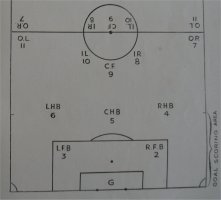
This section lays out the preferred dimensions of the pitch, and although the whole thing is laid out much more clearly than in 1951, little is changed. The centre circle and penalty arc are now using a 5 inch radius, rather than the previous 6 inches. This allows the use of a "10 inch gramophone record" to draw around. This still seems large, but can be reduced if your table is less than the preferred 5ft by 3ft. The rules now state kick off positions "as shown in the plan of the field". The plan is carried over from the earlier rules, but at that time Keeling did not stipulate that the sides had to be lined up in this way (i.e. with the very rigid 1950s formations).
Also added in these rules "Toss a coin; winner selects direction he will play or takes kick-off. A convenient period of play is 20 minutes each way, changing ends at half-time."
MOVEMENT OF THE PLAYERS.
Only method No.1 is left in this section (although method No.2 is in the advanced section). This flick was always the same as in Subbuteo, but here the description could have come from Peter Adolph's rules. "Place the first or second finger, whichever you prefer to use, usually on the right hand (err no), immediately behind the man, the finger tip resting lightly on the table. Press the finger tip into the cloth, then move the finger sharply forward from the middle joint only. DO NOT GRIP YOUR FINGER WITH YOUR THUMB and KEEP YOUR HAND STILL, The men are FLICKED - NOT PUSHED!"
The section then repeats the fairly obvious hints about how to control distance and direction taken from previous rule books.
ELEMENTARY RULES.
Once again, the layout is improved, and the text a little clearer, but mostly the rules are the same. Kick-off, Goal Scoring, and Goal scoring direct from kick-off remain the same. Consecutive kicks by any player (goalkeeper excepted) has been reduced to THREE times in succession, which now matches Subbuteo. However, it does have an exception "...but if the ball has been played into opponent's goal scoring area and the goalkeeper is the only defender in the area, a FOURTH kick is permitted."
CONTROL OF GOALKEEPER. Adds the advise to hold the goal if not secured, and also the following phrase "Attacking side must always wait until defender is in position with goalkeeper before shooting at goal from a DEAD BALL."
GOAL KICKS, FREE-KICKS, and PENALTIES have their flicking distances oddly increased. The player taking the kick now places his man THREE INCHES away from the ball before taking the kick, and the opponents have to stands at least SIX INCHES from the ball. Only with the CORNER KICK is the taker placed ONE INCH away, and I guess that just stops him falling off the table! PENALTY KICKS have proper rules for the first time -
PENALTY KICKS. Place ball on penalty kick spot with man to take the kick standing 3in. away in the penalty arc behind the ball, goalkeeper on goal line and all other players within field of play but outside the penalty area. The kick is taken in the ordinary way but goalkeeper must not be moved until ball has been kicked. If rules are not complied with, penalty kick is retaken.
THROW-IN is no longer illustrated, so there is more of a description thus:- "Place man just over touch line where ball passed out. Hold ball between finger and thumb close behind man's head, then squeeze ball slightly projecting it on to the field of play, touching the head of the man en route, causing man to rock on its base without moving out of position. Ball must not travel a distance equal to more than half the width of the field."
CHARGING gets a clarification - "CHARGING occurs when a man is played against an opponent, moving it out of position, not just making it rock."
INFRINGEMENTS.
These are also little changed from the previous edition. As with the previous rules, a foul is just a mis-flick, while the foul charge is more like the standard foul in Subbuteo. This has been clarified thus:-
FOUL CHARGE. When any of the opponent's men OTHER THAN THE ONE NEAREST TO THE BALL is charged, or this particular man is charged vigorously, or is charged and ball is not played. (this last bit is new, and more like 1950s Subbuteo I think.)
DANGEROUS PLAY is simplified to "if more than one man is flicked at any one time", while the FOUL THROW-IN adds the following infringement "If the ball does not touch the man or moves man out of position".
OFFSIDE players still need to be interfering with the ball (as before), unless they are "nearest man to be ball" when it is played through. ADJUSTMENT OF PLAYERS has the goal kick movement rules, and offside positioning rules, which are unchanged. MEN RETURNING TO THE FIELD is the same as before, as is the IF A MAN FALLS OVER rule (man nearest to the ball takes over - whichever team he is).
The section finishes with some some notes to the referee which add a "drop ball" and clarifies the "shooting outside the goal scoring area" rules thus:-
NOTES TO REFEREE. Should the ball stop and be touching men of both sides at the same time, separate the men 2ins. apart, then drop ball from about six inches so that it falls approximately midway between the men. The side whose player is nearest to the ball when it stops or is touched by the ball resumes play. Adopt this procedure any time there is a doubt about the correct decision, placing a man of each side in position before dropping the ball.
Should the ball be kicked from outside goal scoring area and enter the end, it is a goal kick, even if it touches a stationary man in the area en route. If it touches a defender and crossed goal line, including goal, a corner kick would be granted. If, however, goalkeeper tries to play the moving ball, or a defender tries to intercept it and they touch it, inside the goal scoring area, and it enters net, then a GOAL is allowed. (This always seems harsh, and all the other rules that dissuade shooting from outside the area are rather undone by this one - I find you automatically wave your 'keeper at anything coming towards goal).
If a man is flicked at a moving ball before goalkeeper saves a shot and the ball is played back on to the moving man then rebounds into the net, it is a GOAL. (and strangely satisfying).
PROGRESSIVE "NEWFOOTY" TABLE SOCCER.
Just the renamed Additional Rules section, for players who have "achieved a high standard of play." Most of these are now to do with the goalkeepers.
GOALKEEPER CLEARANCES. Whenever ball stops in PENALTY AREA the goalkeeper is allowed to play the ball irrespective of which side is in play if goalkeeper is nearest man to the ball when extended on wire. If it cannot be reached normally, then the man can be taken off the holder and flicked at the ball from any point the wire will reach, If, however, the goalkeeper misses the ball, the opponent is allowed ONE turn while goal is unoccupied, after which goalkeeper is returned to the wire, and if ball is still in play in the penalty area goalkeeper cannot be again removed from the wire until the ball is cleared from the area.
CONSECUTIVE GOALKEEPER FLICKS. When played as an ordinary man the goalkeeper can only play the ball THREE times in succession, and must not move outside the penalty area to play the ball.
GOALKEEPER PLAYS OUTSIDE PENALTY AREA. If a ball has been passed back to goalkeeper by own side and stops outside the penalty area goalkeeper can be flicked at the ball from goal area but can only play it ONCE; other procedure is as in penalty clearances.
Added to this are rules for using a spare goalkeeper for the first time.
DEPUTY GOALKEEPERS. These have been used for many years and are extra goalkeepers which are brought into play to avoid taking the regular goalkeeper off the wire under the following rule. The deputy can only be used after the ordinary goalkeeper has been withdrawn to the back of the goal, and after use must be immediately removed from the field. Should the regular goalkeeper be brought into play while the deputy is still on the field and the ball touches both men, it is a foul and a PENALTY KICK is taken by opponent. If, however, a goal has been scored, the offence is ignored. If the ball touches the deputy only, then the regular goalkeeper must be withdrawn until ball has been cleared from the penalty area or opponent has taken a turn.
The OBSTRUCTION and INTERCEPTION rules remain as before, and the EXTRA MOVES included (flicking up to three players before a corner, and ONE before a free-kick or throw-in). As before, "no man must be flicked more than once".
The section finishes with some advanced flicking techniques. Here, the old Method No.2 is reintroduced as "FLICKING MAN TOWARDS YOU". This "avoids walking around the table... enables delicate moves to be executed and is useful for imparting spin to a man."
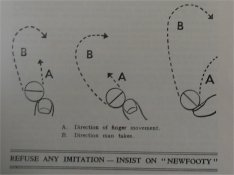
EVASIVE ACTION OR SWERVE has illustrated spin methods that are close to the Subbuteo "Spin" leaflet. These, of course, allow you to "either avoid an opponent or to run around the ball and play it from the opposite side".
The Final Basic Rulebook - mid 1950s-mid 1960s
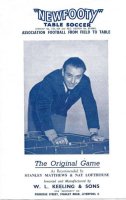
The final Newfooty rules book was this basic version, featuring the classic Stanley Matthews promotional picture on the cover. This picture was also in the centre spread of the green rules. The rules shown here are clearly marked as WL Keeling & Sons, but they were reprinted as a Crestlin booklet for the final couple of years.
This booklet is not dated, so it is difficult to know exactly when it was introduced, but it seems to be part of the budget sets in the mid to late 1950s before becoming the main rules in the Crestlin era. This was a single sheet of paper folded to make four pages, and covers just the standard rules for playing the game, and the progressive table soccer rules presented in the green handbook. Once again, the rules are rewritten but there are no material differences that I can see. The picture of the pitch layout with player positions is reprinted in this leaflet, but much reduced in size. There are no other illustrations. It was originally designed to work alongside the green handbook, as the back page states "The 'NEWFOOTY' HANDBOOK contains more details than this leaflet with illustrations and 'Tactical Talk' which will be appreciated by the 'Newfooty' enthusiast."
That's it for Newfooty rules. If you don't fancy turning off the PC and playing a bit of Newfooty, then you'll have to pick another topic.
[ Main Page ]